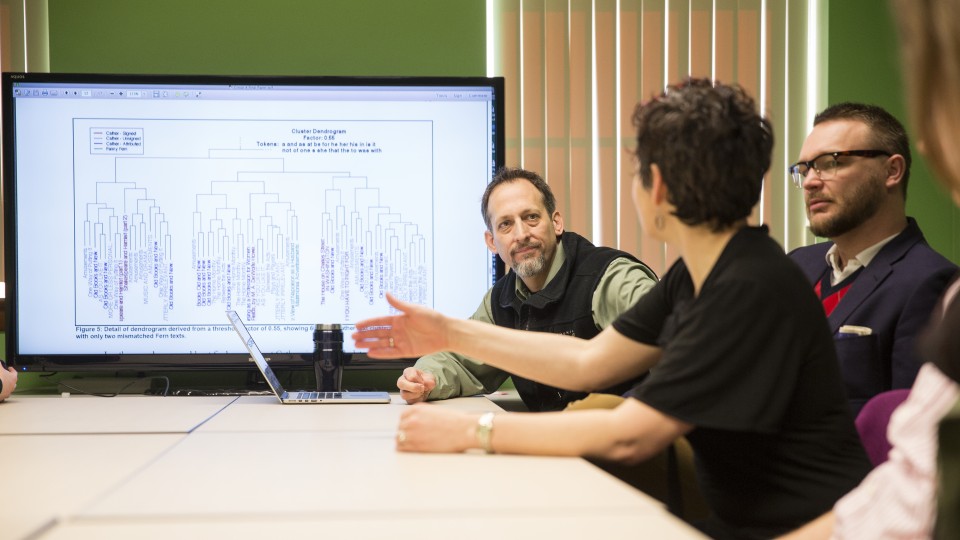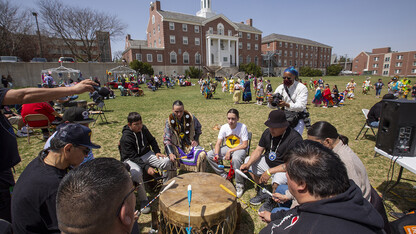· 6 min read
‘Lit Lab’ project collects digital Cather insights

How closely does the narration of Willa Cather’s novels match the personal voice in her private letters? Which unsigned and pseudonymous newspaper and magazine articles did Cather pen during her journalism career? And did Cather’s writing change after she wrote a 1922 manifesto that championed a more spare style for novels?
These are questions recently investigated by University of Nebraska-Lincoln students working in a newly established laboratory for digital literary studies. Their findings have been selected for presentation at the prestigious Digital Humanities Conference in Switzerland in July.
The second of its kind in the nation, the Nebraska Literary Laboratory opened in the fall 2013 semester. The bright space in Love Library, equipped with a giant monitor and a chalkboard, allows students to gather to develop research strategies, write computer code and analyze data.
Matthew Jockers, assistant professor of English and trailblazer in digital literary analysis, created the lab. Jockers, in his second year at UNL, was co-founder of the Stanford Literary Lab in 2009.
Students in Jockers’s fall Microanalysis class dove into UNL’s extensive Cather Archive with a goal of shedding new light on the author’s work. Now, 10 students are to travel to Lausanne, Switzerland, to present their findings. The students competed with established scholars from around the world to gain a place at the prestigious conference.
Computer programming and analysis enabled three teams of students to closely compare 15 novels and hundreds of letters and journalism articles by Cather. Their findings:
- “My Mortal Enemy” was the only one of 15 analyzed novels where the narrator’s voice resembled Cather’s voice in her personal correspondence. The finding backs those of traditional literary scholars, who have also found “My Mortal Enemy” an outlier compared to Cather’s other works.
Using computer analysis, a team made up of Gabi Kirilloff, Laura Dimmit, Chandler Warren and Austin Wehrwein, studied the question. They tracked frequently occurring words such as “a,” “the,” “but” and “and”; and measured sentence length, punctuation and grammar. Cather apparently was skilled at muting her personal voice; in 14 of 15 novels studied, the students found the narrator’s voice to be markedly different from “the personal signal” found in Cather’s letters.
Kirilloff said she came to Nebraska after earning a master’s degree from the University of Rochester because she wanted to study with Jockers and other UNL digital humanities stars.
“They have the best digital humanities program in the country right now,” she said. “The faculty is doing cutting-edge work.”
The recently published book of Cather letters made her team especially eager to compare Cather’s correspondence with her novels.
“A lot of people were surprised by the voice in the letters. It was bold, unabashed, vibrant and quirky – a voice a lot of people weren’t aware of just from her fiction,” she said.
Dimmit said the difference quantified by the students perhaps affirms why Cather was reluctant for her letters, which were published for the first time in Jewell’s book, to be made public.
“The way she writes in the letters – it’s less edited and more dashed off,” Dimmit said. “She’s more emotional and less reserved. She herself thought there was something to the fact that the letters were different.”
- With few exceptions, the unsigned or pseudonymous journalism articles attributed to Cather by scholars match the style and voice of her bylined articles. A team composed of Courtney Lawton, Carmen McCue, Jose Moreno, Ashanka Kumari and Grace Thomas made the finding.
Spurred by a few documented instances of misattribution, the second team set out to create a digital tool to determine whether a newspaper or magazine article was likely to be written by Cather. She may have written about 600 articles, many unsigned or under pseudonym, during her career as a journalist.
Their tool was able to distinguish Cather’s work from that of 19th-century journalist Fanny Fern. But the students’ efforts were hampered because only about a third of Cather’s journalistic output has been transferred to a digital format suitable for analysis.
“We figured out that most of what has been attributed to Cather does indeed match her style used in her signed articles,” Lawton said. “We are confident our computer program works.”
Cather’s writing style did not perceptibly change after her manifesto “The Novel Démeublé,” which suggested a spare approach. A student team of Mikal Eckstrom, Caterina Bernardini, Rebecca Ankenbrand and Alex Kinnaman studied the question.
“We found that her style was largely consistent throughout her entire career,” said Eckstrom. “It really allows us to get some closure through computational analysis because computers typically don’t lie and data stands for itself.”
Andrew Jewell, director of the digital Cather Archive and co-editor of 2013’s “The Selected Letters of Willa Cather,” said the Macroanalysis methods employed by the students hold promise in discovering new insights into authors’ works.
“These techniques apply not just to Cather, of course, but to literature and literary study broadly,” Jewell said. “It’s a way to ask big questions that are not manageable without a computer.”
Jockers said the Nebraska Lit Lab allows students – many of whom have little computer programming experience – to take advantage of one another’s strengths and compensate for their weaknesses. It is a setting where humanities majors can make the important cultural shift from solitary study to collaboration.
“The diversity of experience in a lab like this is really quite important,” he said. “It results in better research and better learning.”
For example, Thomas, an undergraduate who intends to pursue a career in library and information science, is minoring in computer science. Lawton came to UNL specifically to study Cather. Yet Ankenbrand, pursuing a master’s degree in French, had little knowledge of Cather or coding when the class started.
“It was kind of a steep learning curve for me, but I found it fascinating,” she said. “It’s a new way of looking at literature.”
Kumari, who came to UNL seeking a traditional master’s degree in English composition and rhetoric, admits that sometimes she’d still prefer to be alone with her studies. But she saw how her team was strengthened by the diverse abilities of its members.
“Now I’m looking at applying to doctoral programs with a digital focus,” she said. “It’s definitely changed the way I think about my career path.”







